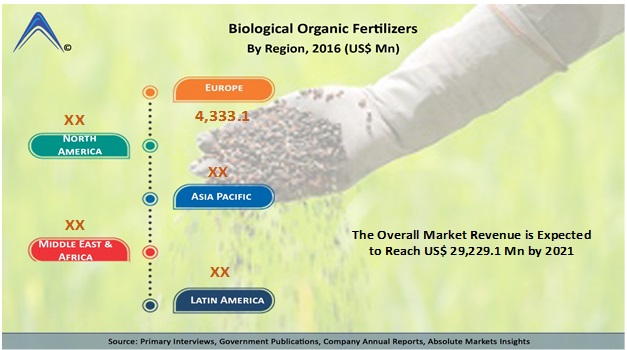
Global Biological Organic Fertilizers Market is estimated to Reach US$ 29,229.1 Mn by 2021, Due to Growing Demand from developing Economies in Organic Food Industry
Absolute Markets Insights offers its latest published report Biological Organic Fertilizers Market by Type (Microorganisms {Rhizobium, Azospirillum, Blue-Green Algae, Phosphate Solubilizing Bacteria, Mycorrhiza, Others}; Organic Residues {FYM, Corp Residues, Green Manure, Others}); by Application (Cereals, Legumes, Fruits and Vegetables, Plantation, Others); by Regional Outlook (U.S., Rest of North America, France, UK, Germany, Spain, Italy, Rest of Europe, China, Japan, India, Southeast Asia, Rest of Asia Pacific, GCC Countries, Southern Africa, Rest of MEA, Brazil, Rest of Latin America) – Global Insights, Industry Trends, Price Trends, Growth, Size, Supply, Demand, Comparative Analysis, Competitive Market Share and Forecast, 2018-2026’. The author of the report analyzed that the Global Biological Organic Fertilizers Market accounted for US$ 16,209.2 Mn in 2016. Adoption of sustainable farming is one of the driving factors for the aforementioned market. Organic fertilizers reduce the dependence on artificial chemical products on different crops and also helps in improving the overall soil, physical structure, biological and chemical composition.
Purchase the complete report titled “Biological Organic Fertilizers Market - Global Insights, Growth, Size, Comparative Analysis, Trends and Forecast, 2018-2026” at https://www.absolutemarketsinsights.com/reports/Biological-Organic-Fertilizers-Market-2018-2026-49

The principal objective of organic farming is to develop enterprises which are sustainable and harmonious with the environment. Increase in population has been a compulsion to stabilize the agricultural production. Hence, growing demand for organic products in the market has led to increased practice of organic farming in many regions worldwide, which in turn is promoting the growth of biological organic fertilizers in the biological organic fertilizers market.
Developing economies lack the knowledge of organic farming due to various factors such as: less awareness regarding bio pesticides, lack of complete package of organic practices, lack of technical knowledge, are some of the factors amongst others responsible for restraining the growth of industry in the global biological organic fertilizers market. However, government is taking initiatives to promote the importance of organic farming in the developing economies, which is likely to increase the adoption of sustainable farming techniques.
There are not only strict organic certification laws in the US, EU, Australia and Japan, but these countries/regions also have their own official organic law, which serve as the sole guideline for high quality organic production. Other Asian countries like China, India, Israel, Thailand and Taiwan have their own official versions of organic standards and rules but have not yet been legislated into laws to include penalty for the violators. Hence, high potential is seen for organic farming in the untapped markets of Asia Pacific region.
The Microorganisms is Anticipated to be Dominant Segment During the Forecast Period, 2018-2026
Microorganisms is further bifurcated into rhizobium, azospirillum, blue-green algae, phosphate solubilizing bacteria, mycorrhiza and others. Among microorganisms, nitrogen-fixing bacteria such as rhizobium and azotobacter are widely applied and are projected to hold a major market share. Soil microorganisms have carbon energy source, which help organic fertilizers to release nutrients slowly and naturally. These microorganisms are used for the control of soil-borne diseases and biological agents, which are applied to crops (Rhizobium etc.) that further help in continuous growth of crops in more efficient manner.
Increasing Demand of Organic Food in North America Drives the Market Growth
The rapid development of the organic agriculture and enhancing demand for organic food in North America is responsible for the overall growth of biological organic fertilizers market. From 2004 till date organic sales in U.S. have increased from 10 billion dollars to 39 billion dollars. U.S. is the second largest fertilizer consumer and leading fertilizer importer in the world. There’s a change in consumer behavior i.e. improved awareness of benefits of organic food. Although demand for organic food is constantly increasing and also the supply shortage is an important issue, which can be solved in future. Organic farming in North America has been in rapid growth in the past years and is projected to expand for continued years.
Biological Organic Fertilizers Market is Fragmented with the Regional and Global Presence
Market participants include Novozymes A/S, National Fertilizers Limited, Rashtriya Chemicals and Fertilizers Limited, Kribhco, Gujrat State Fertilizers & Chemical Ltd, Premier Tech, Madras Fertilizers Limited, Neochim, Camson Bio Technologies Limited, amongst others. In April, 2016, Rizobacter and The Dow Chemical Company collaborated for technological advancements so as to achieve more effective production in Argentina. This collaboration consisted of experts in the biological field, regulatory matters and formulations so as to have products available for the market. This growth aimed to boost the phytosanitary products used in the field, in order to influence sustainable production with less cost and for more efficient usage.
Biological Organic Fertilizers Market - By Types
- Microorganisms
- Rhizobium
- Azospirillum
- Blue-Green Algae
- Phosphate Solubilizing Bacteria
- Mycorrhiza
- Others
- Organic Residues
- FYM
- Crop Residues
- Green Manure
- Others
Market By Application
- Cereals
- Legumes
- Fruits and Vegetables
- Plantations
- Others
Market By Region
- North America
- U.S.
- Rest of North America
- Europe
- France
- The UK
- Spain
- Germany
- Italy
- Rest of Europe
- Asia Pacific
- China
- Japan
- India
- Southeast Asia
- Rest of Asia Pacific
- Middle East and Africa
- GCC Countries
- Southern Africa
- Rest of Middle East and Africa
- Latin America
- Brazil
- Rest of Latin America

